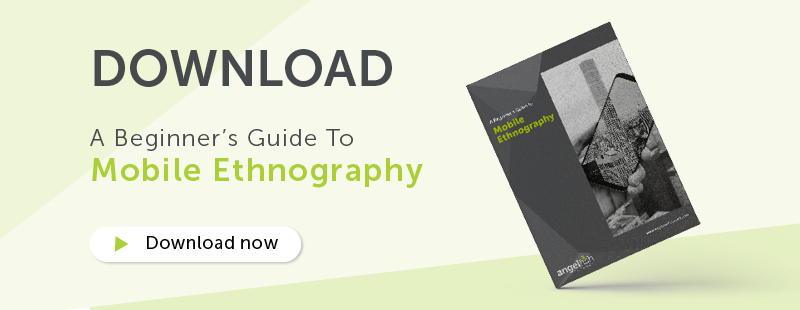
What is Digital Ethnography?
Digital ethnography, also known as digital immersion, is a modern research method that studies people in their everyday environments using digital tools. Instead of bringing participants into a controlled setting, researchers step into the participants’ world, capturing authentic behaviours and experiences as they unfold. Why is it so popular? Well, observing people in their natural environment paints a much truer picture of how they really think and feel than asking them to fill in a questionnaire or chatting to them on the phone. After all, what people say they do and how they behave in real life can be pretty different!
So what exactly is digital ethnography?
Well, digital ethnographic research is the natural evolution of traditional ethnographic research, enhanced by technology. With tools like smartphones, video diaries, and photo uploads, researchers can gain deep insights into participants’ lives without being physically present. It’s fast, discreet, and flexible, making it easier than ever to collect real-time, authentic data.
The power of mobile
There are tons of different ways to carry out digital ethnographic research. From blogging and video diaries to online communities or even accompanied shops, one of the greatest things about digital ethnography is the variety. In addition, because it’s fun, participants will be more engaged - which means you’ll not only have better results, but there will also be fewer dropouts too. The great thing about mobile is that participants are used to using them as part of their everyday lives - which means it's a really natural research tool and makes research effortless because people already know what they need to do. Digital ethnography also easily fits into people’s lives, which means they can take part in research whilst carrying out their everyday activities - and no one around them even needs to be aware!
-Oct-16-2025-08-18-52-5728-AM.png?width=1200&height=628&name=Untitled%20design%20(3)-Oct-16-2025-08-18-52-5728-AM.png)
Honest, insightful results
The true power of digital ethnography comes from the independence it offers. Because respondents are using their own device, it removes the need for a third party advisor or observer - which in turn delivers more honest results. Let’s face it, people act differently when a researcher is in the room with them, and the same is true when they have to stare down the lens of a camera or speak into a microphone. But when it comes to recording themselves on their own phone, it’s completely different. People today are constantly snapping photos and uploading videos using their mobile, which means that when taking part in digital ethnography they won’t modify their behaviour in any way.
In-the-moment feedback
Another big benefit of digital ethnographic research is that it is instant. With digital ethnography, you can gather customer insight in real-time as they interact with products, as opposed to a few hours or even days later when they might have forgotten what really happened. For example, in an accompanied shop, your participant might really rate the level of service in a store but find it hard to navigate - and this in-the-moment feedback as and when it is happening can add a new layer of depth and integrity to your research. And since all data is recorded digitally, it no longer needs to be inputted and results don’t need to be written up - saving time and reducing the risk of data misinterpretation too.
Flexibility and reach
Another benefit of digital ethnography is that unlike traditional ethnography, it’s not bound by geographical restrictions. Because there’s no need for researchers to travel to respondents, it increases the pool of potential candidates too, which is especially helpful if you are dealing with strict criteria. Not only that, but digital ethnography also saves time and money - and logistically it’s much easier to plan, too! Additionally, digital ethnography is much more flexible than traditional methods, which means if you’re not quite getting the data you were hoping for, you can tweak things as you go along.
Things to consider
Of course, no methodology is perfect - which means there are still some things you need to consider if you decided to use mobile ethnography as part of your next research project. It’s really important to carefully consider issues surrounding privacy, security and reliability, so be careful to choose the right software for your project. Additionally, make sure you plan things thoroughly and fine tune your screening process to ensure this more relaxed approach for research won't be taken advantage of.
Ready to get started?
From video diaries to accompanied shops, digital ethnographic research gives researchers an unbeatable opportunity to peek into respondents’ lives more easily than ever before. It’s good fun, it fits in around peoples busy lives, and it also empowers participants - making it a winning methodology in our eyes!
Ready to explore digital ethnography for your next project? Download our free beginner's guide and start gathering real-time insights today.
Further Reading
If you found this article helpful, you might also enjoy:














